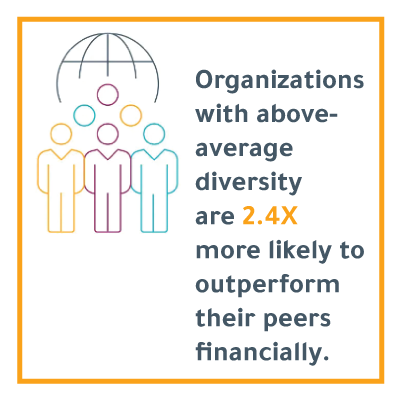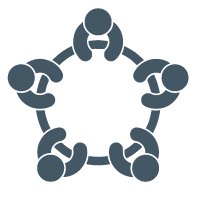Inclusive leadership is critical to help your organization become a more diverse, equitable, and inclusive workplace. With their words and actions, leaders influence company culture and set the tone for embracing diversity in the workplace.
Unfortunately, when leaders rated their organization on key factors tied to advancing diversity, equity, and inclusion (DEI), only 25% felt that inclusion is a strong part of their organization’s vision and values. So, there is work to be done at many organizations, and a good place to start is with a company’s leaders.
But how do you know if your leaders are embracing diversity? What leadership behaviors promote diversity and inclusivity?
Like the journey of becoming a skilled leader, embracing diversity and inclusivity is also lifelong. So, it can be difficult to know where to start in your workplace or how to measure progress.
To accelerate diversity and inclusion in the workplace, it’s important to first understand your people. What is their experience in the workplace? Do employees feel included, valued, and able to be their authentic selves? How are leaders already cultivating an inclusive environment?
Knowing your leaders’ and teams’ perceptions provides valuable insight to help you consciously chart a way forward.
What Is Diversity in the Workplace?
Diversity often refers to the visible differences that we see at first glance: gender, age, race, or physical disability, for example. But there are many differences that cannot be seen: personality, culture, experiences, beliefs, invisible disabilities, sexual orientation, identity, and ethnicity.
Ultimately, to embrace diversity is to embrace all the ways that someone is unique—the diversity that is seen, not seen, said, and unsaid.
One Leader’s Story of Realizing the Value of Diversity
In a coaching conversation, a leader told me they learned, “by chance,” that a new team member had a different perspective on the department’s change plan. The leader had been told about the idea by a member of the leadership team. The idea was a good one, and it influenced the leader’s approach to the change plan.
In this case, the reason the leader wasn’t aware of his team member’s perspective was because he didn’t ask everyone on the team for reactions and feedback. Reflecting on the experience, the leader realized that, when he did seek other perspectives, he often relied on the same group of people for feedback—a group that shares many of the leader’s own characteristics (known to him as his group of “trusted advisors”). The new team member was working fully remote, and the leader reflected that he would likely need to be more intentional about reaching out because they are unlikely to see each other in the office regularly.
This behavior is common, particularly among leaders. Research reveals that more than half of leaders don’t invite ideas from others.
There are many layers to this story that highlight challenges leaders face when embracing diversity in the workplace. It is natural to seek out people with shared characteristics and similar perspectives. And the added challenges of a hybrid and remote workforce do not make it any easier.
Different ideas can create conflict. And conflict can disrupt teams if we don’t have the skills to create a culture of trust and resolve it fairly. So, understandably, many people avoid diversity and conflict, let it escalate, or fail to embrace it as an opportunity for growth and learning.
But healthy and productive workplaces are rich with diversity.
Leaders have the unique responsibility to help teams invite different perspectives and unlock the out-of-the-box problem solving, innovation, and creativity that comes with it.
Benefits of Diversity and Inclusion in the Workplace

Companies take a big risk by making decisions in an echo chamber. Scott Page, author of The Diversity Bonus, showed when you solve problems from predominantly one perspective, your impact will be limited—it adds an error rate of about 30%.
Page’s research also shows us that diverse groups outperform groups of like-minded experts. Diversity spurs innovation and engagement—and better financial results.
According to DDI’s Diversity, Equity, and Inclusion Report 2023, organizations with above-average diversity are 2.4X more likely to outperform their peers financially. Companies that are more inclusive tend to be stronger at attracting and retaining all types of talent and are much more likely to be ranked as a “Best Place to Work.”
How to Embrace Diversity at Work: 8 Strategies
Here are eight strategies for how to embrace diversity in the workplace:

1. Start the conversation.
It can be difficult to find the right way to start. Leaders need to open the door, set the tone, and send the message that they care about diversity, equity, and inclusion. Like the leader I referred to earlier, reflect on your own experiences and consider what your teams could gain from leveraging more diversity.
When did you realize you had an opportunity to embrace diversity? Have you observed or experienced excluding behavior? What impact did it have? Use that momentum and your authentic experience to become open and vulnerable with your team.

2. Increase accountability and transparency.
Without transparency and understanding of what you are doing to increase DEI, teams will not feel that there is enough being done to make improvements. Additionally, a continuing transparent conversation ensures efforts are aligned to the most important areas.
Consider who has the most critical role in driving diversity, equity, and inclusion at your workplace. (Hint—it’s your leaders.) How explicit is it that your leaders are accountable?

3. Develop inclusive leadership skills.
Do your leaders know how to be inclusive? Being aware of unconscious bias or the business case for DEI is not enough. Awareness is an important step, but it doesn’t automatically lead to action. Leaders need training to learn the tools, frameworks, and skills to bridge the gap between theory and practice.
Teach your leaders how to create an inclusive environment with a blended learning approach that engages leaders’ heads and hearts.
However, be wary of separating inclusion as a separate skill or additional thing to do. It isn’t something to apply in certain situations but not others. It can be woven into the actions leaders and associates take each day. I encourage you to reflect on this mantra: Great leadership is inclusive leadership.

4. Notice diversity during discussions and decisions.
While anyone can be a victim of unconscious bias, those who are disproportionately harmed include women, people of color, people with disabilities, members of the LGBTQ+ community, and people who are perceived to be from a foreign country.
Bias has very real consequences that affect hiring decisions, performance management, delegation, and succession decisions. To embrace diversity means to pay attention to who is at the table and then create a diverse table.
Leaders need to create conditions where diverse viewpoints are represented, be purposeful in seeking out people who have opposing views, delegate equitably, and proactively identify development opportunities for all.

5. Pay attention to how all people are treated.
Hybrid and remote work highlight growing challenges for DEI efforts. Some minority groups have reported virtual work to be a relief, with home being a safer place with reduced discrimination and microaggressions (whether indirect, subtle, or unintentional).
Conversely, for introverts, it can be easy to feel lost or unsupported behind their screens, compromising neurodiversity.
We know flexible work offers huge benefits, but it also risks widening the diversity gaps and creating new ones. To embrace diversity, leaders must pay attention to how all people are treated in any work environment, and focus on increasing fairness.
Leaders must be intentional to engage and acknowledge each person and their value through verbal and nonverbal microaffirmations.
Above all, consider what you can do to create a psychologically safe work environment where everyone feels that it is safe to speak up, be heard, and be their authentic self.

6. Act as a vocal ally.
Being an ally is like being a catalyst for change. We’ve all observed disrespectful or excluding behavior. But do you intervene when you notice unfairness?
Embracing diversity means advocating on behalf of others and creating fair conditions for everyone. Acting as an ally becomes even more critical when supporting historically excluded groups that face unique challenges.
For example, women often experience inequality as they move up the leadership ladder. Women benefit tremendously from having allies to support them in ways such as building networks, increasing their visibility, amplifying their voice, and ensuring credit is assigned fairly.
To be an ally, you must act with courage and empathy. Allies may need to “call-in” individuals to address their exclusionary actions or words and provide honest and empathetic feedback. Allies hold people accountable for fostering a high level of inclusion and respect and redirecting a conversation to be more inclusive.

7. Reflect and commit to change.
Part of enhancing a culture of diversity, equity, and inclusion requires leaders to look inward. Consider your own leadership strengths and opportunities and then take action. Use self-insights to make a commitment and ask for feedback.

8. Build your platform on empathy, feedback, and psychological safety.
Taking action to embrace diversity requires everyone—it is an individual, team, and organizational effort. If socializing calling-in behavior becomes important, be mindful that this can feel uncomfortable at first. It can also be tough for teams if giving feedback is not part of the culture.
Teams may fear being punished or have concerns about the reactions from others when speaking out. This is hard, so all involved should be extremely considerate of others by maintaining their colleague’s self-esteem and demonstrating empathy. After all, some microaggressions are not intentional. Empathy is key.
On this journey of striving for equality, your teams are likely to be doing their best. But as leaders, you can spread the message that they can always be doing better. Leaders must role model the behaviors they want to see in their teams and develop their own feedback receptivity. Embracing diversity is making the development of psychological safety a key priority in teams.
Embracing Diversity Is Realizing You Are Better Together
Embracing diversity in the workplace requires you to continue this dialogue. So, it’s important to discuss what your business and teams specifically need. And it’s important to remember that organizations that get this right will need to experiment, get things wrong, and learn.
Recognize that what you are trying to do can be hard and involves disrupting deeply ingrained habits and biases. So, I offer you this moment now to acknowledge all the ways that you and others are showing up already to embrace diversity. Celebrate effort, acknowledge progress, and challenge yourselves and others to be better together.
For more on how to embrace diversity in the workplace, including data and best practices, check out our Diversity, Equity, and Inclusion Report 2023.
Katy Freeman is a product manager with DDI. Each day gives her an opportunity to understand what leaders out there need and develop a learning strategy to help make leadership easier. She enjoys leadership programs, coaching and feedback, and loves spending time in nature. Connect with Katy: https://www.linkedin.com/in/katyfreeman/
Topics covered in this blog

